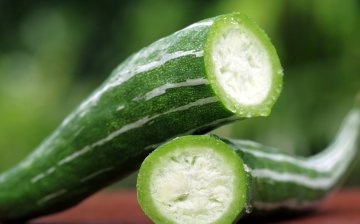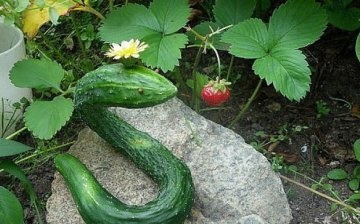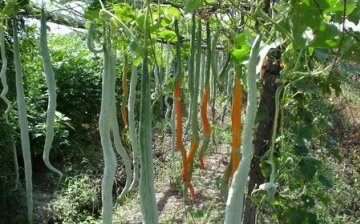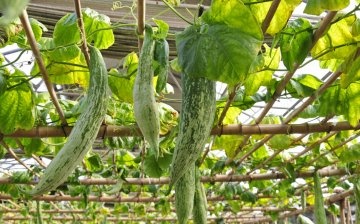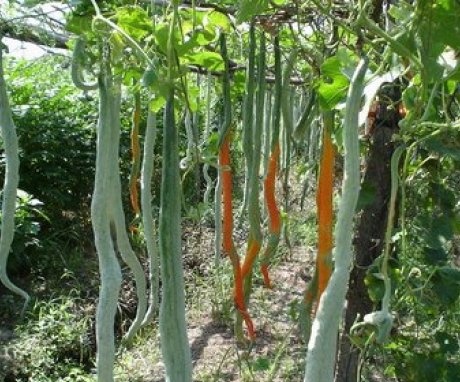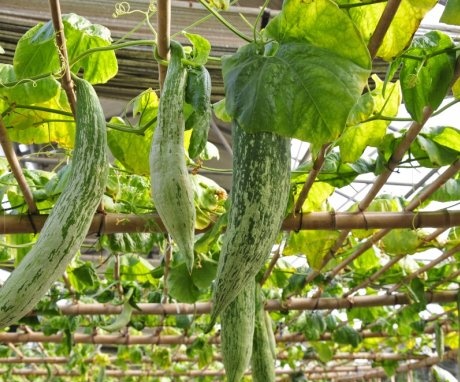Trichozant - an exotic cucumber on your site
The plant with the exotic name "Trichozant" is very popular in tropical countries. Any parts of it are eaten there: stems, leaves, antennae. We call a trichozant cucumber, but this is a liana from the Pumpkin family. It is not difficult to grow this amazing plant in the garden, and its shoots and fruits are very nutritious and rich in vitamins and microelements.
Content:
Description and features of cucumber
The plant has a rather thin stem, it curls and can reach 3 m in length. The fruits of the trichozant are also very unusual. At first, they look like curly or straight Chinese cucumbers, and then, as they ripen, they turn yellow or red, acquire a pumpkin color. The shape and color of the fruit largely depends on the variety.
The length of the fruit can be more than a meter, and the diameter is up to 10 cm.
There are seeds inside the fruit, but there are not many of them, about 10 pieces per fruit. They are quite hard, pumpkin-like. Trichozant can undoubtedly be eaten, it is very useful. But also as an ornamental plant, it can decorate your site. Curly vines appear on curved fruits, also called snake cucumbers. They are very popular in Asian cuisine, where both fruits and stems are eaten raw as green vegetables.
Bloom trichozant looks very beautiful. The flowers are white, covered with a long fluff and resemble snowflakes. They have a pleasant aroma and will undoubtedly decorate the garden area. Flowers bloom only in the evenings and, despite their wonderful scent, do not attract insects. You need to pollinate them manually.
Any part of the plant can be used. The fruits are eaten, the decoction of the stem removes the heat, the root is used to treat eczema and wounds, the decoction of the seeds also relieves the temperature and acts as a diuretic.
Fruits contain many vitamins, as well as calcium, potassium, iodine, and iron.
It is especially recommended to pay attention to this plant for people with diseases of the cardiovascular system. Trichozant can be consumed fresh, as it is more useful. However, well-ripened fruits become bitter and have a peculiar smell that not everyone likes. The smell disappears during heat treatment. From the fruits of the trichozant, you can prepare main dishes, side dishes, and also pickle them.
Dried and crushed the seeds Plants are used to treat skin diseases, added to masks and creams, to remove scars, scars, stretch marks. The trichozant has no contraindications. The only obstacle to its use may be allergies or aversion to taste and smell.
Proper plant care
You don't need to be an experienced gardener to grow this exotic plant; beginners can do it too. Trichozant is not much different from the usual cucumber, perhaps more love for warmth. A heat of 30 degrees is familiar and even pleasant for him.
A number of rules for caring for a trichozant should be followed in order to harvest has always been rich:
- Trichozant grows well in greenhouses, because it loves heat and does not tolerate cold. But if the summer in your area is warm enough and the temperature does not drop low at night either, you can grow it outdoors.
- Plants should not be planted early, otherwise night frosts will prevent them from developing.It is best to plant a trichozant in May, when it is already warm enough even at night.
- It doesn't matter what kind of cultivated plants grew at the place of planting of the trichozant, but you should not plant it after the pumpkin plants.
- Trichozant loves moisture. It is desirable that the humidity is 80%. This can only be achieved in a greenhouse.
- During the period of active growth, you need to regularly water the plant, preventing the soil from drying out. After glaze you need to loosen the ground in order to ensure the flow of air to root system... Can mulch.
- For the entire growth period must be at least 5 top dressing... Trichozant responds well to organic and mineral fertilizers... When the fruits begin to form, you need to fertilize the plant once a week. You need to water after dressing.
- Despite the relationship with pumpkin, no diseases and pests, characteristic of pumpkin, were not observed, so it is not necessary to carry out any preventive procedures to combat pests.
- It is possible to pollinate the plant by hand, but this is not necessary. It will bear fruit itself until the first frost.
- Since the trichozant is liana, you need to prepare supports for it. One plant can grow up to 4 meters, so you need to think about how and where you will attach the shoots.
- After fruiting the seeds can be collected and stored. They can be stored for up to 6 years in a dark, dry place and remain viable. It is advisable to leave 1 stem, so the processes need to be pinched as they grow.
Reproduction and cultivation methods
Trichozant breeds seeds... Inside the fruit, you can find seeds that need to be dried and left until spring or stored for several years before planting. For reproduction, you need to choose even seeds from ripe and healthy fruits.
Trichozant cultivation is best done by seedling method. Planting seeds directly into the ground is quite dangerous, since early planting will freeze thermophilic sprouts, and late planting will delay the appearance of the crop.
Growing a trichozant:
- For the seeds to sprout better, they must be soaked in honey water before planting. It is best to germinate seeds in wet sawdust. They need warmth, about 30 degrees. By about the fifth day, the seeds hatch.
- When the seeds have sprouted, they can be sown in the ground. This is done in mid-April, so that in May it is already possible to plant a trichozant in the garden. The seeds are planted in the soil shallow, no deeper than 2 cm.
- Care seedlings most common: regular watering, good lighting, warm.
- As soon as 5 leaves appear on the seedlings, pinch the top.
- After a month and a half, the seedlings are ready for planting. It is better to choose a warm and sunny day for planting. If you are planting in a greenhouse, the weather is not so important.
- Remember that the trichozant grows a lot. Do not plant seedlings close to each other. They will intertwine, interfere, and it will be difficult to tie them up. The optimal distance between saplings - half a meter or a little more.
If you live in a warm region with hot summers, it is quite possible to plant seeds directly into the ground. In a sufficiently warm and humid climate, the seeds planted in the ground will take root well, and the yield will be large enough, since there will be no need to decide how to transplant the trichozant, which does not really like such procedures.
It is also necessary to plant seeds in the ground sprouted.
Germinate they are in wet sawdust, and when they have small roots, they are planted in the soil. You need to plant seeds when the frost will definitely not return, that is, in mid-late May. Before this, it is advisable to fertilize the soil with mineral fertilizer.
Trichozant needs to be tied up regularly. But if the cultivation takes place in the greenhouse, the plant can itself cling to the film with its antennae.
More information can be found in the video.



